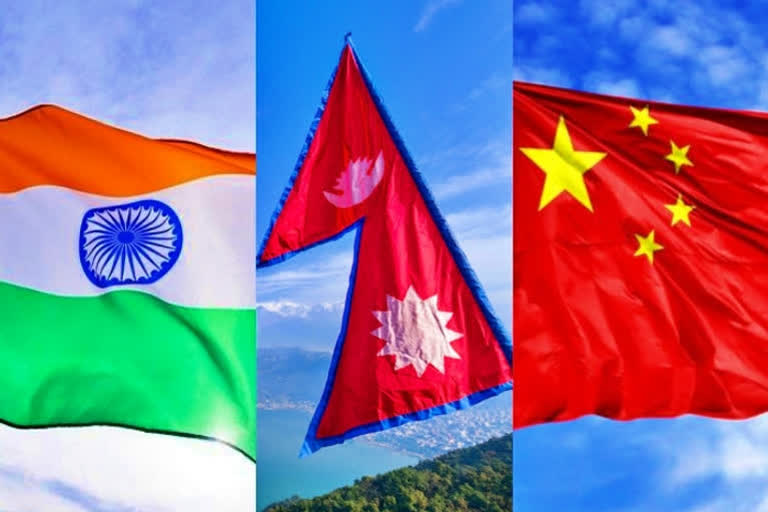New Delhi: The meeting of the Standing Committee of the Communist Party of Nepal scheduled for 8th July has been postponed again in order to find an amicable solution of the impasse thus giving another short reprieve to Khadga Prasad Sharma 'Oli', Nepal’s Prime Minister.
Amid the growing tension between India and Nepal, seemingly instigated by China, the latter’s actions are rightly perceived by the masses and Nepali politicians as a blatant interference in its internal affairs by China.
The Indian Government has also been blamed by the opposition for failure of its foreign policy to sustain the centuries’ old best relations with Nepal, characterised by Roti- Beti (relation of bread and matrimony). This accusation is baseless. No two neighbours, like no two family members, can sustain the same degree of relations forever. Tensions between them are likely to erupt sometimes depending on the prevailing circumstances.
India and Nepal are no exceptions. During the monarchy, Nepali kings kept accusing India of trying to topple them in favour of democracy. This reached a crescendo in 1975 when, afraid of meeting the fate of Sikkim, Nepal proposed to be declared a “zone of peace” with no military competition on its soil.
While China and Pakistan, grabbing this opportunity to impress Nepal, readily signed such agreements, India refused on the grounds that there was already a comprehensive Peace and Friendship Treaty between the two nations.
Refusal of Nepal to renew the treaty in 1988 led to simmering tensions resulting in a sort of economic blockade of Nepal, to be resolved only in 1991 with signing of two separate treaties. A similar situation presented itself in 2015 when the amendment in Nepali constitution angered the Madhesi population (people of Indian origin settled in Nepali plains).
However, the current crisis is due to Indo- Nepal border disputes which has its genesis in the British India- Nepal treaty signed in Sugauli in 1816 defining Nepal’s western border up to the origin of river kali and here lies the point of dispute. While India perceives that Kali originates near Lipulekh pass, Nepal contends that it’s origin is further west near Limpiadhura, thus laying its claim over a part of Uttarakhand.
Also Read: India-Nepal border row: Stamp becomes tool of protest
Oli, a second timer PM, hastened to get a revised Nepali map passed by the Parliament in order to divert the attention of his people from the rampant corruption and countrywide criticism on his unusually intimate relations with the Chinese Ambassador Ms. Hou Yanqui. His reluctance to vacate the post for the other party Co-Chairman Prachand despite such an understanding has eroded Oli’s support base in the party.
Oli’s unsubstantiated accusation against India for fanning discontent within the party has further angered the leaders and alienated him in the party. And here enters Hou Yanqui with her relentless efforts to save Oli. In case of Yanqui’s numerous meetings with the President and PM, all protocol was thrown out of window which raises doubt about possible ulterior motives behind the meetings.
One might ask why and how China is meddling in India- Nepal relations. Reasons are obvious- firstly China would like to extend its debt trap to Nepal by offering ostensibly lucrative projects under its Border Road Initiative at the cost of Indian investment in and assistance to Nepal.
Secondly, China wants to increase its influence in Nepal to convert the latter into a Chinese protectorate to the discomfiture of India. Thirdly, it wants to give a subtle message to all other countries in SAARC that China and not India, is capable of developing the region.
Last, but not the least, China wanted to pressurise India by opening another front in Nepal and thus divert global attention from the criticism it faces on various issues relating to trade and human rights.
China’s modus operandi is to crush Nepal under the Chinese debt and compel it to do China’s bidding. Currently, China is involved in many projects in Nepal including an airport in Pokhra, a university, construction of many roads including one terminating at Indo- Nepal border, dams and a mega railway project connecting Tibet with Kathmandu through tunnels in the mountainous region, the later costing US$ 6 billion (600 crores ).
Nepal’s current debt to China is approximately US$ 2 billion which will jump to $ 8 billion including the Railway project, a whopping 29% of its GDP projected for 2020! Since Nepal is most likely to default on Chinese loans resulting in China’s debt trap. But perhaps Chinese strategy has backfired.
The intense opposition of Oli in his party, the disclosure of China having encroached upon Nepali territory at various places, economic non-feasibility of the railway project (dubbed by many in Nepal as the paper project) and romancing with China at the cost of India have resulted in protests against him. Of late, Nepal has shown flexibility towards India by removing many police posts it had recently established along the Indian border.
However, the definitive trend in relations would be visible only after the next meeting of the Party’s Standing Committee whenever it happens.
Also Read: Economic blockade of 2015 pushed Nepal towards China: Experts



